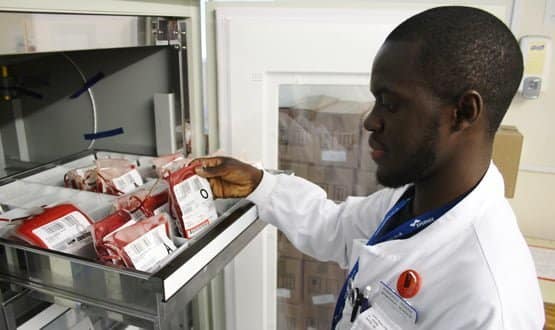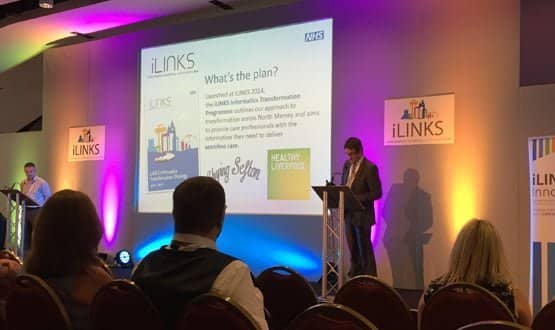Bloody good ideas
- 15 July 2015

The introduction of e-prescribing at Oxford University Hospitals is one of the biggest change programmes the trust has ever seen.
On the day prior to Digital Health’s visit to the John Radcliffe Hospital, there were around 1 million transactions on the trust’s Cerner electronic prescribing and medicines administration system. Nearly 19,000 medications were prescribed and there were almost 5,000 unique log-ins.
“That gives an overview of the size and scope of the project we are running,” says pharmacy clinical services manager Paul Devenish.
He explains that the project is substantial because it crosses boundaries between all working groups.
“We have spent so many years using paper; to go from paper to electronic in six months is a fundamental change to practice and how well it’s been accepted is a testimony to how well people deal with change.”
Start at the beginning
Oxford began a seven stage e-prescribing roll-out across all of its directorates last October; and finished in May. Prescribing is now done on computers on wheels in all inpatient departments, except maternity, and the roll-out to outpatients will start next month.
Devenish says that by working in phases, the team has learned as the project has progressed. By the time they got towards the end, roll-out was quite fluid.
“Before we went live there was some anxiety about how long things would take. The work I have been involved with to date has shown there are some things that take longer; but in most cases that’s a benefit because it adds to safety and addresses long-standing problems we had with paper.
“In most cases, for day-to-day provision of care to patients, I don’t think it’s made a huge change,” he adds.
The trust introduced the system with some decision support, but turned off many of the alerts available as it did not want to deter doctors from using it.
“If tons of alerts come up you become alert-fatigued just clicking through it. During development we thought through that and decided: ‘Lets limit the amount of decision support to what’s required then start turning it on as people become more familiar with the system’,” explains Devenish.
Decision support for prescribing high-risk medication like Insulin and Warfarin involves pre-developed power plans to help doctors prescribe and prompts to order certain tests.
The system also cross-checks for any allergies and drugs cannot be prescribed if a patient does not have an allergy status completed. At the bedside, patients are identified via a bar coded wrist band before drugs are administered.
Robotic working
In the pharmacy, a robot’s long arms are stretching into stacks of broad flat drawers as it picks prescriptions and files away boxes of medications.
Using a bar code scanner, and by assessing the size of the box, it knows what medicine it has picked up and remembers where it is stored.
In use at Oxford for the past two and a half years, Devenish is not aware of any other pharmacy robot used in the NHS that also labels drugs with how to take the medication and who it is for.
A pharmacy tracker allows nurses to see where a discharge prescription is in the system, allowing them to better plan their upcoming bed space. The hospital also has complete traceability from when a doctor prescribes a medication to when a nurse administers it and a discharge medication is created.
Devenish says pharmacists love the electronic system as it removes the risk of their not understanding a written prescription. “Overall, there’s a sense that it has improved safety because it has removed a bunch of risks that were there with paper,” he says.
A bloody process
In the trust’s blood transfusion lab, paper is again conspicuous by its absence. Oxford first piloted an electronic transfusion management system in 2001 and it was implemented trust-wide in 2006-7.
This involves all patients and blood having bar codes that must be scanned and checked to ensure the right blood is given to the right patient.
Consultant haematologist Mike Murphy explains that at most hospitals checks before a blood transfusion are done at the bedside by two nurses and involve around 27 steps on paper. The online process can be done by one nurse in just 16 steps.
Despite the electronic system devised at Oxford winning a series of awards and interest from the Quality Innovation Productivity and Prevention programme, it has yet to be rolled out nationwide.
“Unfortunately it hasn’t been implemented through the NHS; a lot of innovations just don’t get rolled out for all sorts of reasons. The biggest thing is inertia, hospitals find it very difficult to do new things when they are struggling so hard to do what they are currently doing – even though it’s incredibly inefficient,” he says.
John Radcliffe Hospitals houses NHS Blood and Transplant, where Murphy also works. He says this close relationship has allowed them to develop a paperless system for ordering replacement blood for the unit.
Most hospitals, when they need new blood, either send a fax or ring NHS BT and request it. At Oxford, NHS BT has a direct link to the trust’s fridges and can dispatch replacement product without anybody making a request.
The final piece in the electronic jigsaw is the introduction of electronic ordering of blood by clinicians. This started in the haematology department in April last year and is being rolled-out trust-wide.
The Cerner module of the EPR is not live anywhere else in the NHS and Murphy says Oxford has even gone further in digitising the process than some US trusts that use it.
Oxford’s blood bank team work with their US colleagues to share experience and data and are “inundated” with visitors from the UK and overseas, keen to see what the trust has achieved.
By building clinical decision support into the system around blood transfusion triggers, the trust has managed to reduce its use of blood products dramatically, saving £500,000 over the past year.
Every year 10-15 people receive the worst kind of wrong blood transfusion which can kill, so if the system was implemented nationwide it could save lives, Murphy believes.
“The trust were very keen when they knew Cerner was coming to get some good news stories because they realised that a lot of clinicians would find using electronic systems for all their procedures difficult,” says Murphy. “There will be ongoing savings as we roll-out across the trust; we have got a big job to do now.”


